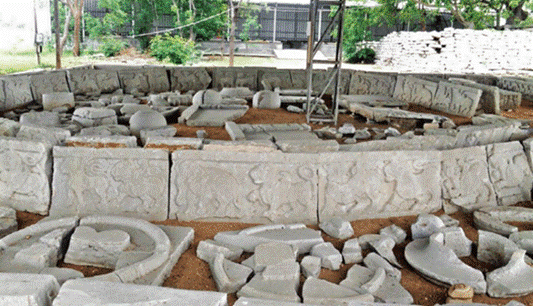History and Art and Culture
In News: Hardly paid attention to for two decades, Archaeological Survey of India has now taken up conservation work at this important Buddhist site near Kalaburagi.
- The ancient Buddhist site on the bank of Bhima river near Kanaganahalli (forming part of Sannati site) in Kalaburagi district, has finally got some attention.
- The conservation project taken up now envisages the resetting of the remains of Maha Stupa retrieved in the excavation
- The stupa was built with locally available limestone.

About the place
- Sannati and Kanaganahalli were small and ordinary villages on the bank of Bhima till 1986 when the Kali temple at the Chandralamba temple complex in Sannati collapsed.
- In the process of clearing the debris, they discovered an Ashokan edict which put the villages on the world map and opened new avenues of historical research on Mauryan Emperor Ashoka and Buddhism in its early years.
- It prompted the ASI excavations at Sannati and nearby Kanaganahalli and attracted historians across India and beyond.
Kanaganahalli excavation
- An ‘abandoned well’ in the eyes of local villagers turned out to be the magnificent Maha Stupa, which was referred to as Adholoka Maha Chaitya in the inscriptions.
- More significantly, the stone-portrait of Emperor Ashoka, surrounded by his queens and female attendants was also found
- While the Stupa is believed to be one of the largest of its time, the stone-portrait is considered to be the only surviving image of the Mauryan Emperor which had the inscription ‘Raya Asoko’ in Brahmi on it.
- The Maha Stupa is believed to have been developed in three constructional phases – Maurya, Early Satavahana and Later Satavahana periods stretching from 3rd Century B.C. to 3rd Century A.D. The Stupa is believed to have been destroyed in an earthquake.
The recoveries included
- around 60 dome slabs with the sculptural rendering of Jataka stories, Portrait of Ashoka, Shatavahana monarchs and certain unique depictions of Buddhist missionaries sent by Ashoka to different parts;
- 72 drum-slabs decorated with a variety of Dharma-Chakras, Stupas, the first sermon, Bodhi-tree, Naga Muchulinda, Viihara complexes;
- Over 10 inscribed sculptures of the Buddha, over a dozen Buddha-Padas;
- Fragments of Ayaka pillars, umbrella stones and shafts, parts of sculptures of Yakshas and lion and 250 Brahmi inscriptions with varied paleographical features.
Source: The Hindu
Previous Year Question
Q.1) Site of Ashoka’s major rock edicts Location in the State of (2022)
- Dhauli — Odisha
- Erragudi — Andhra Pradesh
- Jaugada — Madhya Pradesh
- Kalsi — Karnataka
How many pairs given above are correctly matched?
- Only one pair
- Only two pairs
- Only three pairs
- All four pairs











